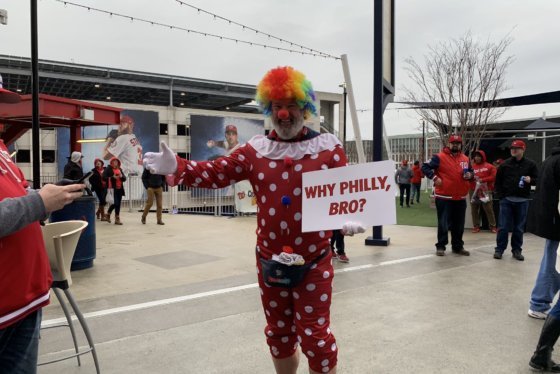The last time the Philadelphia Phillies came to Washington with this much hype, it was for Bryce Harper’s very first appearance against them, as a precocious, teenage rookie in 2012. After a half-decade of NL East dominance by Philly, the Nationals front office had created a stir by only selling tickets to residents of the DMV, trying to shut out Phillies fans from infesting so-called “Citizens Bank South” once again, to try to inject life into what was a one-sided rivalry.
That series was originally called Take Back the Park Weekend, but by the time it — and Bryce — actually arrived in D.C. (these were his sixth, seventh and eighth big league games), it had been adorned #NATITUDE Weekend. Because Bryce was #NATITUDE, and this was his coming-out party.
After winning the first two games of the series, the finale brought ESPN to town for Sunday Night Baseball for the first night since the ballpark opened. It brought Cole Hamels hitting Bryce Harper in the back, the tinder needed to set everything aflame, and the gasoline can of Harper’s payback, straight-stealing home on national television.
The Nationals dominated the Phillies from then out, going 77-55 against them during Harper’s stay in D.C. He took back Nationals Park that night, even in what ended up being a loss. The only thing anyone really remembered was that moment.
Tuesday night was just one game, but that all looked like ancient history by the time it was over.
Of course it rained. It seems like it always rains these days. It was raining when the Lerner Family reportedly offered Harper his extension, in the middle of a game, last September. It was raining when Harper skidded over first base at Nationals Park in August 2017. It was raining when he hit his very first big-league home run, an otherwise forgettable blast off San Diego Padres journeyman Tim Stauffer in front of far fewer than the announced crowd of 19,434 that evening.
Tuesday night, despite the rain, a full 35,920 showed up to see what would happen next. Nationals fans reprised the role of the Philly faithful, booing in full force upon his introduction. They were equally vociferous for his first two at-bats and were treated to two early strikeouts courtesy of Max Scherzer, the opposition ace. But Harper got every laugh after that, each louder than the one prior.
He doubled in the fifth in a rally that would fizzle. By the time he doubled again in the top of the sixth, this time capping a four-run outburst that put the Phillies ahead 6-0, many — at least those in Nationals red, white and blue — had made their way toward the exits. It was nearly 10 p.m., it was still rainy, it was a Tuesday night with little left to see, as a Nats fan.
Oh, but some remained. They witnessed the coup de grace — both of them, really, the 458-foot missile into the second deck in right and the 1080 windmill bat flip straight into the depths of hell.
A glorious, defiant bat flip pic.twitter.com/PCcLzRpBBm
— adam ferrone (@_rone) April 3, 2019
With one swing, an emphatic gesture (in the direction of the Nats dugout, no less) and a bow to the remaining Philly faithful in right field as he came out to his position in the bottom of the inning, Harper had reclaimed Nats Park once again as his own, but this time for the dreaded visitors.
There were other echoes of that long ago Sunday Night Game. The more important immediate outcome, though not the banner headline, was that of an injured star player, out indefinitely. In 2012, it was Jayson Werth’s graphically broken wrist on a sliding catch attempt; Tuesday night, it was Trea Turner’s mangled index finger on his throwing hand, dislodged while trying to lay down a bunt.
Some of the Nats fans at the park Tuesday night decided to invoke Jonathan Papelbon, the malcontent closer who, before his Homer Simpson parenting routine in 2015, occupied the same role for the Phillies back in 2012. One fan wore a Papelbon shirsey. One emphatically carried a sign reading PARDON PAPELBON. Another had a DC STRANGLER jersey customized in the team store.
Whatever the number 58 means to Nationals pitcher Jeremy Hellickson (he’s worn it his whole career) it’s merely a terrible stroke of luck that Papelbon wore that same number first in D.C. But so it was that when Hellickson entered a nearly lost cause of a game in the eighth inning and fed an 89-mile-per-hour, middle-in fastball on a tee to Harper, he crushed it into oblivion out of the hands of a Nats pitcher wearing No. 58.
It’s all meaningless and silly, but so is baseball. Far more meaningful was Bryce’s and Philly’s reclaiming of territory at Nationals Park, and the fact it took just over seven innings to do so after seven years of such dominance while wearing the Curly W.
We’ve always known Harper is worth more than just the sum of his stats, but such things can be hard to quantify. If it wasn’t obvious what the Nats have lost and the Phillies have gained before Tuesday night, it certainly was by the time it was over.





